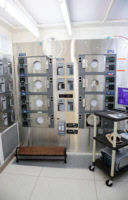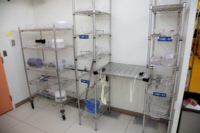Equipment
| Lab and Coral Name | TRL / A2-WetOxBond |
| Model | MRL 718 |
| Specialist | Bernard Alamariu (Eric Lim) |
| Physical Location | 4F Entry Diffusion |
Classification
| Process Category | Diffusion |
| Subcategory | Oxidation |
| Material Keywords | SiO2 |
| Sample Size | 6" Wafers, 4" Wafers |
| Alternative | TRL / A1-GateOx |
| Keywords | multi wafer, manual load, multiple pieces, both sides of sample, conformal dep, temperature, manual operation |
Description
A2-WetOx is an atmospheric furnace designed to grow thermal SiO2 (and anneal) in the temperature range of 800-1050C on Si wafers without any prior metals or III-V processing. Wet oxidation is available using a pyrogenic reaction with H2 and O2. Multistep process recipes (time and gas flows) can be programmed using the associated Sequencer. The temperature profile is separately adjusted using an Eurotherm controller. Center zone temperature can be set directly. Set points for Load and Source zones must be adjusted relative to the Center zone by the user to achieve a flat temperature profile. Wafers are loaded manually with a boat loader and two quartz rods.
| Best for | Thicker oxides grown by wet oxidation |
| Limitations | |
| Characteristics/FOM | Gases: N2, O2, H2, Steam |
| Caution with | |
| Machine Charges | 25/run + 10/um |
Documents
SOP
| Tube A2 | SOP for the wet oxidation tube A2 |
Process Matrix Details
Permitted
Germanium on surfaceSamples with germanium on the surface (typically grown films)
(A), Germanium buriedSamples with germanium buried below a different film
, PiecesWafer pieces may not be handled by the equipment, and are harder to thoroughly clean - preventing them from running in certain tools.
, Been in the STS DRIEThe DRIE etch leaves behind polymer residues on the sidewall ripples, which can be a contamination concern for some tools.
, Been in the SEMA sample viewed in the SEM must have used the appropriate chuck to avoid cross-contamination
(With Appropriate Chuck), Been in the Concept1The Concep1 deposits dielectrics on GREEN wafers, however it also accepts metal and there can be cross-contamination for diffusion area
, Coming from KOHAfter a KOH etch, the samples must receive a special clean because the K ions are highly contaminating to CMOS frontend tools
, Coming from CMPAfter a CMP, the samples must receive a special clean, because the slurry residues otherwise introduce contamination and particles.
, Requires TRL RCA CleanAn RCA clean in TRL was carried out immediately before
(Must do)
Not Allowed
Ever been in EMLSamples from EML are never permitted to return to ICL or TRL
, Been in the ALDSamples that have been in any of the ALD systems
, Pyrex SubstratesPyrex substrates can be a concern due to high sodium content, which contaminates CMOS frontend tools
, III-V SubstratesAny III-V substrates, e.g. GaAs, GaN, InP, and so on. Note though that many common III-V substrates will also carry the Au flag, but there are some GREEN III-V substrates.
, Gold or RED color codeRED color code substrates. These are gold-contaminated or have been processed in gold contaminated tools. Gold and other metals can contaminate silicon devices (GREEN color code) and have to be separated.
, Any exposure to CMOS metalIf the sample had ever seen a CMOS metal (or a tool that accepts CMOS metal), then some frontend tools could be contaminated by this.
, CMOS metal on surfaceCMOS compatible metals exposed on the surface. These are Al,Ni,Pt,Ti,TiN. Other metals such as Au are *NOT* part of this.
, CMOS metal buriedCMOS compatible metals covered entirely by a different material. These are Al,Ni,Pt,Ti,TiN. Other metals such as Au are *NOT* part of this.
, Has PhotoresistSamples with photoresist cannot be exposed to high temperatures, which is typical in deposition tools. Outgassing can be a concern.
, Has PolyimidePolyimide is a very chemically resistant polymer, and can tolerate higher temperatures but cannot be exposed to typical PECVD deposition temperatures or diffusion furnaces. Outgassing can be a concern.
, Has Cured SU8Not fully cured SU8 residues can heavily contaminated plasma chambers or destroy other user's samples, but fully cured SU8 is permitted in certain tools.
, Has been past RCA clean for over 4 hoursFor some diffusion furnaces, the samples must immideatly enter the furnace and cannot be stored in a box for a long time.
For more details or help, please consult PTC matrix, email ptc@mtl.mit.edu, or ask the research specialist (Bernard Alamariu)

